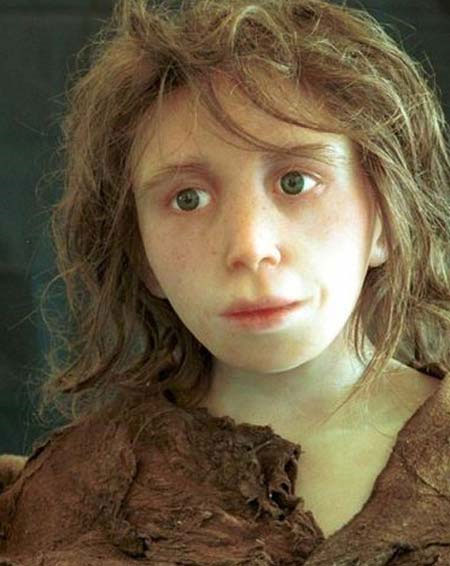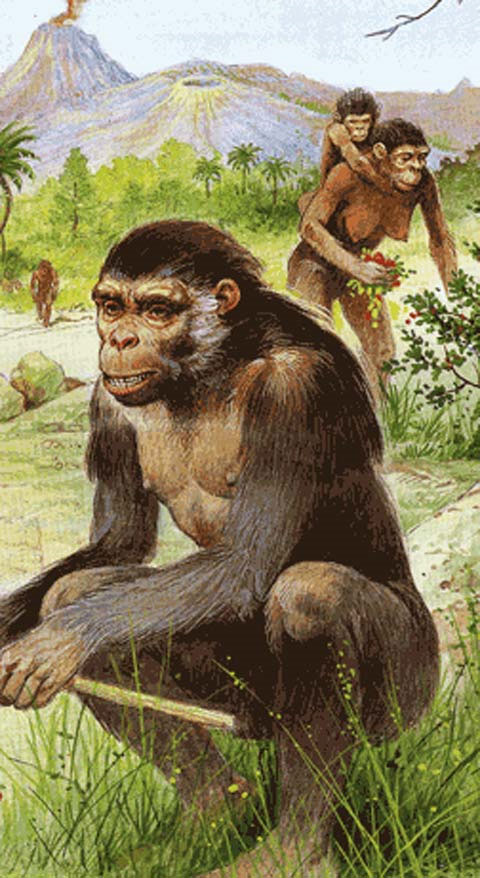The findings identify human origin
Benjamin Franking King, Jr. once said: 'It seems that we humans are living in ambiguity, drifting indefinitely in space from here to here. Nobody knows where our origins come from, and where our species will go. '
At the beginning of the 19th century, French naturalist Jean Baptiste Lamarck, after studying fossils, argued that organisms change their behavior in response to changes in their environment. which leads to changes in physical structure (eg, giraffes 'pull' their necks to reach the upper leaves).
In the middle of the 19th century, Alfred Russel Wallace and Charles Darwin, two British researchers, were at the same time independent of each other giving ideas about evolution: although individuals of the same species have a majority The same characteristics, however, still have a few individuals with some more beneficial aspects of survival. If these individuals reproduce, these beneficial differences will be maintained and become distinct characteristics in future generations.
Through many researches, discoveries and corrections, scientists have gradually clarified and since then made assumptions with authentic scientific evidence of human evolutionary history. The article is compiled and published in Discovery magazine .
Neanderthal fossils 1856
In 1856, for the first time a fossil was identified by scientists as fossils of prehistoric humans discovered in Neander Valley (Germany) . But this is not the first fossil to be excavated. Previously, in 1829 and 1848 similar fossils were discovered, but did not pay attention to its importance.

These fossils are very important, they show that Neanderthals lived only 200,000 to 28,000 years ago, meaning that they live in the same age as modern humans. When compared to other prehistoric varieties, scientists also found that Neanderthals have large brains similar to modern humans; and there is evidence that they know how to use tools, know how to hunt, build shelters and make clothes. They also know how to decorate artifacts as a hobby, not merely worry about survival. Moreover, they also have the custom of burying the dead and sometimes decorate the graves.
Homo erectus (Homo erectus) 1891

The oldest fossil belongs to a family discovered in Africa, but the next important fossil is excavated on another continent. In 1891, fossils found in Indonesia were identified as the oldest fossil family in Africa. This fossil was identified as a vertical person (Homo erectus) who lived about 1.89 million years ago - 70,000 years. Related fossils were later found in Africa and other parts of Asia.
According to research evidence, the upright family has developed a number of similar traits to modern humans such as relatively long legs, short hands - this may be because they have no habit of climbing trees regularly. The nostrils are very large, and there is a slight change from the others, which is the downward nose. The difference in size of males and females also decreased. In addition, they also have behaviors similar to modern people. They know how to use fire to process food, heat and protect themselves.
Taung baby fossils 1924

Although there is evidence that the oldest ancestors lived in Africa, it was not until 1924 that the first fossil was discovered of our oldest ancestor on this continent. Fossils are named ' Taung children' discovered in South Africa. This is the fossil of a child who lived about 2.8 million years ago. The markings of the claws and beaks left by the eagle on the skull indicate that the baby was killed by the bird. Taung belongs to the family Australopithecus africanus , and at the time of excavation, it was the first evidence of our ancestors' vertical walk.
Fossil of "skillful guy" 1960
In 1960, scientists unearthed a previously unknown fossil in Tanzania, and during the excavation process, they discovered some stone tools. This fossil was later named Homo habilis , meaning "clever guy" . The skull size of the fossil shows that this 'guy' has a fairly large brain, along with his tools, that scientists think Homo habilis was the first ancient family to use tools and craftwork.

'This clever guy' lived about 2.3 to 1.6 million years ago. However, since 1960 onwards, some ancient dating tools have been discovered. Therefore Homo habilis may not be the first to know how to use the tool.
Fossils of Lucy 1974
Perhaps this is the most famous fossil among the fossils of the species ancestors ever discovered . Lucy was discovered in 1974 in Ethiopia. The origin of the name of this fossil is quite romantic. Scientists have given this specimen a very human name - Lucy - because during excavation, they often open a Beatles tape, including ' Lucy in the Sky with Diamonds'.

Lucy of the family Australopithecus afarensis , lived about 3.85 to 2.95 million years ago. More than 300 fossils of the same type have been discovered, so Australopithecus afarensis became one of the most abundant ancient human data sources for researchers.
This fossil was especially important because at the time of excavation - in 1974 - Lucy was the first representative to move with two legs of our ancestors, although she was still good at climbing and having face structure as well as small brain size like apes.
Orrorin tugenensis fossils 2000

In 2000, an ancient human fossil found in Kenya was determined to live about 6 million years ago. The fossil of this Orrorin tugenensis is not only the longest-lasting fossil found, but there are also signs that it can sometimes go straight . Another finding surprised the researchers, this fossil shows that the species has a thumb that can move towards the opposite side of the other hand on the hand. Previously, the fact that thumbs could move opposite to other fingers is thought to be related to the ability to use tools, but when this was discovered in Orrorin tugenensis , this argument was no longer stable. half.
Ardi Fossil 2009
In 2009, an excavated fossil in Ethiopia revealed to scientists how our ancestors lived.Ardipithecus ramidus (Ardi for short) is a geographically 'neighbors' with Lucy, who lived about 4.4 million years ago. The name of this fossil means 'ground' or 'root', implying that the ape does live on the ground, which also implies the origin of their family tree.

Ardi carries the characteristics of apes such as long and curved fingers, the thumb with the feet can move to the opposite side compared to the remaining fingers (very convenient for climbing on trees). On the other hand, the pelvic and foot bones shape allows it to go straight. However, there is also controversy around this important fossil. These are the fossils of trees found with Ardi to indicate that the 'girl' lives in the forest. Previously, scientists still believed that our ancestors' transition to straight walking was due to a change in habitat, from dense forests to plains. Therefore, the findings related to Ardi have shaken this assumption.
Stone tools discovered in 2010
In 2010, after a study, scientists discovered that Homo habilis was not the first person to use the tool. The 3.4 million-year-old animal bone fossils found in Ethiopia have revealed deformed traces such as being smashed or cut off - these traces are thought to be caused by human tools. Hunt them.
Researchers said Lucy and her relatives, Australopithecus afarensis, used homemade tools to make food. However, there is no evidence that this species knows how to build tools for hunting or other activities.
Neanderthal genetic project 2010
From the thumb on the opposite side, to go straight, then know how to use fire, is there any genetic difference between our ancestors? To answer this question, a group of international researchers have carried out a difficult and complex project, the study of DNA of modern and Neanderthal-like people. They analyzed DNA samples from three Neanderthal bones found in Croatia and compared the results with five DNA samples of modern humans in South Africa, West Africa, Papua New Guinea, China and Western Europe.

The analysis of these specimens is complicated, in part because the Neanderthal bone fossils were contaminated by the attack of microorganisms and due to human impact during excavation and storage.
After analysis, the scientists found that about 1-4% of the genes of modern Europeans and Asians are associated with Neanderthals. The African DNA does not show any connection with the Neanderthals. These results negate previous assumptions about the segregation of human species, instead leading to a hypothesis that there may be cross-breeding between some ancient families with Neanderthals.
Latest findings 2010

Cave where the latest fossils are discovered.
During an excavation of a cave in South Africa in 2010, scientists discovered some fossils. The specimens discovered included some remnants of a woman and a boy of about 2 million years old , in addition to the bones of a newborn baby and another adult woman. These fossils were named Australopithecus sediba , which showed that this breed was taller and healthier than Lucy's, with two long legs indicating that this person moved with two legs and had a longer stride than the others. like the previous one.
Controversy appears in research circles on the classification of these fossils. Although they were originally classified as Australopithecus , some researchers have argued that these fossils are closer to our species - Homo sapiens, and therefore should be classified as Homo.
Many undiscovered fossils, plus modern technology and further analysis of future studies, will undoubtedly shed light on the history of our human origins.
- How to read UPC bar codes to identify US, Japanese or Chinese goods
- Identify human identity by bacteria
- New archaeological findings in North Africa may
- Unexpected announcement of the origin of sand on Mars
- 'Small' findings help people 'live longer'
- 10 most archeological findings (2)
- The 10 most remarkable scientific findings of the year
- 'Shocking' findings about your body
- The oldest detection of human DNA can rewrite human evolutionary history
- New discovery of human evolution
- Launch the human cell mapping project of the century
- New technology helps identify people through gait
 'Fine laughs' - Scary and painful torture in ancient times
'Fine laughs' - Scary and painful torture in ancient times The sequence of numbers 142857 of the Egyptian pyramids is known as the strangest number in the world - Why?
The sequence of numbers 142857 of the Egyptian pyramids is known as the strangest number in the world - Why? History of the iron
History of the iron What is alum?
What is alum?